When I started my garden last year, I focused primarily on choosing native butterfly/caterpillar and hummingbird plants, and I kept telling my husband about how different our yard would look next year (which is now this year). But I knew that he wouldn’t really get into it until he saw his first hummingbird. For my husband, hummingbirds remind him of visiting his grandparents in Uvalde, and so the little birds are quite special to him. Now that our garden is growing and we get hummingbirds regularly, it’s fun to watch my husband get such enjoyment out of our garden.
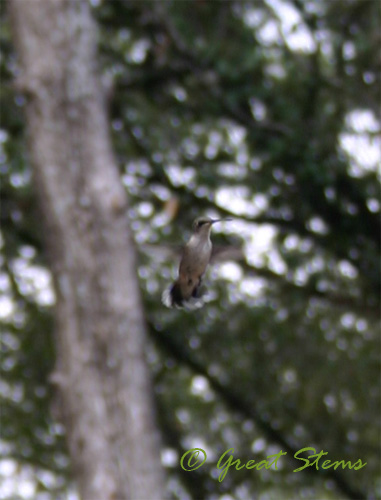 We have many varieties of hummingbird plants now, but the plants are still more or less small, so the main visits are to the feeders, though I’ve seen visits to the Salvia and Flame Acanthus. We had just one feeder up for many months, and then a few days ago, I found a second hummingbird feeder in the back of our garage, and we set it out. I don’t know whether it was the combination of two feeders or the fact that migration is underway, but that very day we had five hummingbirds zooming around. We sat out on chairs and enjoyed trying to identify them. I couldn’t get pictures of them all at once — they were all flitting about trying to push the others away from feeders while trying to sneak in some sugar themselves.
We have many varieties of hummingbird plants now, but the plants are still more or less small, so the main visits are to the feeders, though I’ve seen visits to the Salvia and Flame Acanthus. We had just one feeder up for many months, and then a few days ago, I found a second hummingbird feeder in the back of our garage, and we set it out. I don’t know whether it was the combination of two feeders or the fact that migration is underway, but that very day we had five hummingbirds zooming around. We sat out on chairs and enjoyed trying to identify them. I couldn’t get pictures of them all at once — they were all flitting about trying to push the others away from feeders while trying to sneak in some sugar themselves.
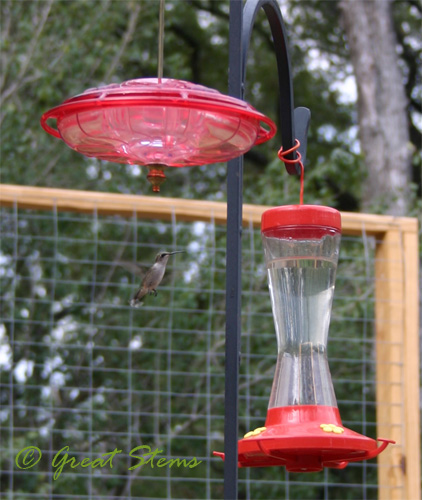 Of the two feeders, I much prefer the UFO-shaped HummZinger feeder over the taller, more traditional feeder. There are a few reasons for this, but primarily the Hummzinger is much, much, much easier to clean, and it has a built in “moat” to keep the ants out. It’s all plastic, which is a bummer, but the design is sound and it feeds da birdies, so I forgive it. It helps keep the wasps out, too. It’s also more affordable than the blown-glass feeders, which my dogs would break anyway. It’s very noticeable how quickly the liquid goes down in the tall one, so I’m not sure if it means the tall one is the first choice for the hummingbirds. This is worth investigating!
Of the two feeders, I much prefer the UFO-shaped HummZinger feeder over the taller, more traditional feeder. There are a few reasons for this, but primarily the Hummzinger is much, much, much easier to clean, and it has a built in “moat” to keep the ants out. It’s all plastic, which is a bummer, but the design is sound and it feeds da birdies, so I forgive it. It helps keep the wasps out, too. It’s also more affordable than the blown-glass feeders, which my dogs would break anyway. It’s very noticeable how quickly the liquid goes down in the tall one, so I’m not sure if it means the tall one is the first choice for the hummingbirds. This is worth investigating!
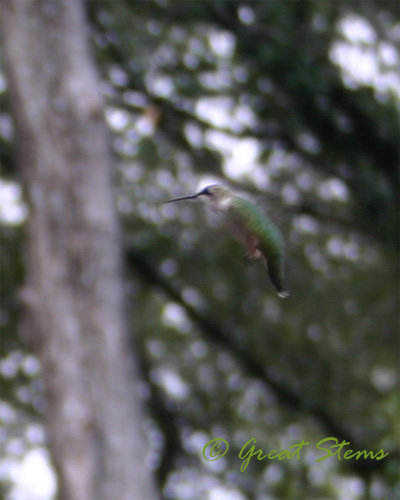 We had to visit one of the big building stores yesterday for house repair stuff, and as I wandered through the garden center just to see what was there, I passed by a couple buying hummingbird feeders and food. I decided to offer them some friendly advice, that making your own sugar water is better than buying commercial syrup because red food coloring is reported to be dangerous for hummingbirds, plus making your own saves money. But this couple just looked at me quite annoyed, and the husband stated that hummingbirds won’t come to the feeders unless it has the red liquid, and I could tell by his tone that he considered me to be foolish and ignorant and that I needed to mind my own business. So I said very pleasantly that yes they do come to the feeders without red liquid, and I moved on, hoping that because the wife also said that they would, that maybe she’d actually someday stop buying the red liquid. But I’m not so sure the husband will. Tried to help. Denied. Move on. Clearly this guy is not a friendly garden blogger or garden blog reader!
We had to visit one of the big building stores yesterday for house repair stuff, and as I wandered through the garden center just to see what was there, I passed by a couple buying hummingbird feeders and food. I decided to offer them some friendly advice, that making your own sugar water is better than buying commercial syrup because red food coloring is reported to be dangerous for hummingbirds, plus making your own saves money. But this couple just looked at me quite annoyed, and the husband stated that hummingbirds won’t come to the feeders unless it has the red liquid, and I could tell by his tone that he considered me to be foolish and ignorant and that I needed to mind my own business. So I said very pleasantly that yes they do come to the feeders without red liquid, and I moved on, hoping that because the wife also said that they would, that maybe she’d actually someday stop buying the red liquid. But I’m not so sure the husband will. Tried to help. Denied. Move on. Clearly this guy is not a friendly garden blogger or garden blog reader!
But I thank him for the inspiration behind today’s post — tips for attracting hummingbirds to your yard, with details on feeders and making the syrup.
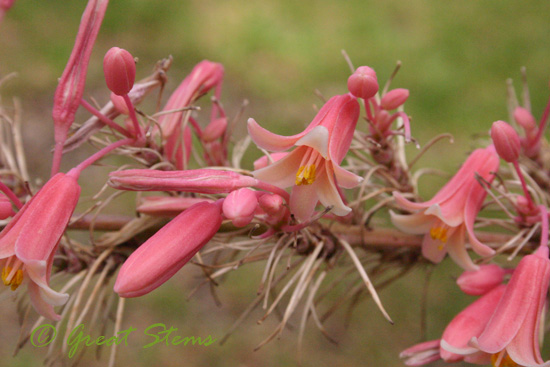
- Do plant nectar-filled native plants (tubular ones are particularly attractive to the birdies). Here in Austin, some favorites are Turk’s Cap, Flame Acanthus, Red Yucca, Crossvine, Coral Honeysuckle, among others.
- Set out hummingbird feeders as well (edit: unless you live in an area with bears — eep! thanks, RoseyPollen). Hummingbirds consume plant nectar and tiny insects for vitamins and protein, and they use a feeder’s sugar water to fuel their crazy energy needs. Hummingbird feeders with perches give tired birds a chance to rest a moment while they feed.
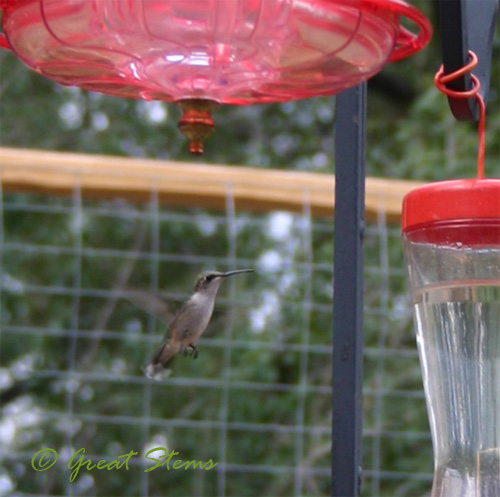
- Make your own sugar syrup for the feeders. Don’t buy red commercial products. Use one part white cane sugar to 4 parts water. According to hummingbirds.net, you don’t have to boil the water first, but you do need to replace the feeder’s syrup every three days and replace stored, refrigerated syrup every two weeks. They also state that turbinado sugar and beet sugar are NOT good choices, so stick to the white cane sugar (I laugh because I’m trying to steer my family away from white sugar but I feed it to the birdies? ha). And absolutely NO honey or gelatin or food coloring. I mix:
1 cup white sugar
4 cups water - Clean the feeders regularly (give a good hot rinse each time you replace the syrup; every 3 or so weeks for a major cleaning), but NOT with bleach or soap or detergent or anything toxic. Some sites say to use bleach, but bleach is extremely bad for the environment and potentially reacts with the plastic as well, so I don’t use or recommend it. Vinegar is a great alternative to bleach, but no matter what you use, rinse extremely well.
Other than that, be patient. This time of year, many hummingbirds are in migration. Next month, my family is going to the Gulf of Mexico to hopefully see migrating hummingbirds en masse, so I hope I’ll get a few good pictures to share.
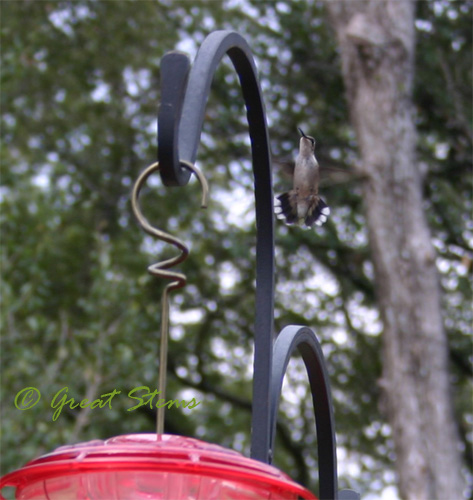 FYI, I looked into making my own hummingbird feeders with recycled bottles. But upon investigation, I learned that the long tubes used for the typical upside-down feeders, homemade or store-bought, tend to leak, causing all sorts of problems. I decided to save the money and avoided purchasing the tubes. I still hope to make my own someday, but I won’t be using an upside-down version.
FYI, I looked into making my own hummingbird feeders with recycled bottles. But upon investigation, I learned that the long tubes used for the typical upside-down feeders, homemade or store-bought, tend to leak, causing all sorts of problems. I decided to save the money and avoided purchasing the tubes. I still hope to make my own someday, but I won’t be using an upside-down version.
Meredith, what a nice post about hummers. I’ve spotted them this week on my Mexican honeysuckle and flame acanthus.
Pam, thank you. We’re enjoying the antics of our little bird friends. We have a new one that must be migrating — he almost looks like a Rufous, but I haven’t been able to get a picture to study him more closely. Striking markings, though.
Hey,
I used to think you only had to plant salvias, and fuschis, and lots of other fancy stuff to attract hummers. Turns out , my geraniums are something they enjoy as much as the other stuff. who’da guessed?
And I don’t put up feeders anymore because of bears. I still have hummers.
Rosey
BEARS! Wow — I never thought about them having interest in hummingbird feeders. Wow, I just saw a video of a bear licking out the sugar water. Ok — adding a note to my blog entry! Thanks, Rosey.
Awesome! Hummingbirds are such delights to watch. I have yet to capture any on film, so kudos to you Meredith! In fact, I saw 2 in the garden just today and I couldn’t get to my camera fast enough. Darn’t all.
Do you know if we should take the feeders down on a certain day so that hummingbirds will be encouraged to migrate? When I lived in Uvalde an experienced hummingbird watcher told me to take the feeder down on October first
Thanks!
The feeders do not affect migration at all — the hummingbirds are driven by other forces. You should actually keep your feeders up year round for the stragglers that come through (be sure to clean and replace the sugar water just like you would the rest of the year, every 3 days). This info comes from hummingbird expert and author Sheri Williamson. Also, you can up the ratio to 3:1 water to sugar in winter to give extra energy for the birds and help them continue on their way. 4:1 is the regular amount, and in the summer it’s good to switch to a 5:1 ratio during the hot summer, to help the birds get extra water. Good question — glad you asked!